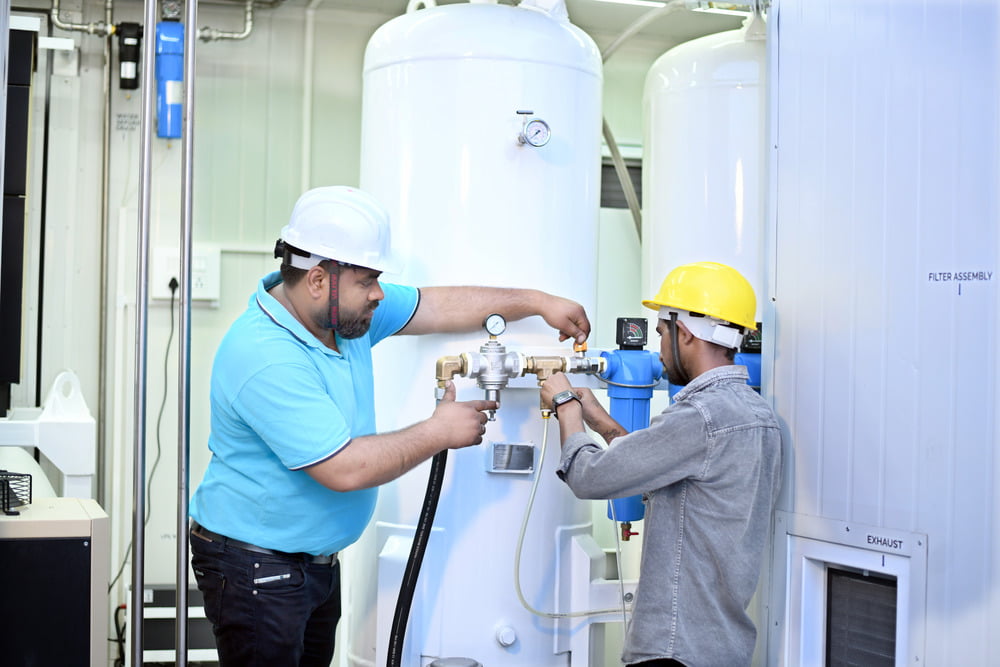In the ever-evolving landscape of industrial safety and operational efficiency, the strategic use of nitrogen purging techniques has become nothing short of indispensable.
This article aims to shed light on the critical role nitrogen purging plays in various industries and introduce the revolutionary technology of Pressure Swing Adsorption (PSA) Nitrogen Generators, ushering in a new era of controlled purging processes.
The Concept of Nitrogen Purging
- Oil and Gas Industry:
The oil and gas sector, fraught with volatile substances, relies heavily on nitrogen purging to ensure safety and prevent catastrophic events. During maintenance, shutdowns, or pipeline modifications, nitrogen purging proves pivotal in removing combustible gases. The blanketing technique, often employed in storage tanks, creates an inert atmosphere, mitigating the risk of fire and explosion, and providing a safeguard for both personnel and infrastructure.
- Pharmaceuticals:
In the realm of pharmaceutical manufacturing, where precision and sterility are non-negotiable, nitrogen purging emerges as a key player. Utilized in packaging processes, nitrogen displaces oxygen and moisture, preserving the quality and integrity of sensitive pharmaceutical products. The controlled environment created by nitrogen purging is instrumental in ensuring the efficacy and longevity of pharmaceutical substances, meeting the stringent standards of the industry.
- Electronics Industry:
The electronics industry, reliant on intricate and delicate components, places a premium on preventing oxidation and corrosion. Nitrogen purging, integrated into manufacturing and assembly processes, creates an oxygen-free environment. This not only safeguards electronic components against degradation but also ensures the reliability of electronic devices, a critical factor in an industry where precision is paramount.
Here’s a 5 -minute read on The Importance of PSA Oxygen Generators in Medical Applications
PSA Nitrogen Generators: A Technological Breakthrough
- Principle of PSA Technology:
The advent of Pressure Swing Adsorption (PSA) technology has marked a paradigm shift in nitrogen generation. This groundbreaking technology operates by selectively adsorbing oxygen and moisture from compressed air, allowing nitrogen to pass through for use in various industrial processes. The result is a highly efficient and cost-effective method for on-site nitrogen production, providing industries with newfound flexibility and control.
- Benefits of PSA Nitrogen Generators:
Cost Savings:
PSA Nitrogen Generators eliminate the need for bulk nitrogen storage and transportation, significantly reducing operational costs. The ability to produce nitrogen on-site reduces dependency on external suppliers, contributing to long-term financial efficiency.
On-Demand Production:
These generators offer nitrogen on-demand, ensuring a continuous and reliable supply. This eliminates the downtime associated with traditional nitrogen delivery methods, contributing to increased productivity and operational continuity.
Customizable Purity Levels:
PSA Nitrogen Generators provide the unique advantage of customizable purity levels. Industries can tailor the nitrogen output to meet specific requirements, ensuring precision in applications ranging from pharmaceutical manufacturing to electronics assembly.
Conclusion
In conclusion, the symbiotic relationship between nitrogen purging techniques and PSA Nitrogen Generators is reshaping industrial practices across diverse sectors. The ability to create controlled atmospheres, prevent oxidation, and enhance safety underscores the pivotal role of nitrogen purging in ensuring the integrity of industrial processes.
As technology continues to evolve, PSA Nitrogen Generators stand as a testament to innovation, offering industries a sustainable, efficient, and reliable solution for their nitrogen needs. Embracing these advancements not only unlocks precision in processes but also contributes to a safer and more cost-effective industrial landscape.
Related posts:
- Torch Metal Cutting Oxygen Purity 94%: The Ultimate Guide to Achieving Precision Cuts
- Nitrogen and its Importance in the Pharmaceutical Industry
- How Nitrogen Enhances Safety and Efficiency in the Electronics Industry
- Sustaining Industry with PSA Nitrogen Generators A Deep Dive into Applications
- Industrial Applications of PSA Nitrogen Generators


